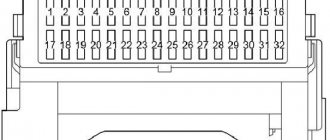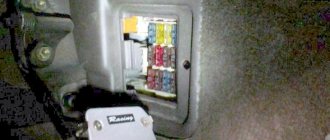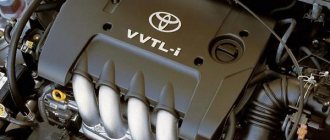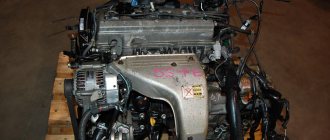Toyota has been producing the iconic Land Cruiser SUVs since the 50s. But the idea of creating a small universal all-wheel drive vehicle that could be used on light off-road conditions appeared only in the 90s. And so, in the mid-90s, the premiere of one of the first compact SUVs, the Toyota RAV4, took place.
A year after its debut on the market in a 3-door body, a 5-door version appeared in 1995. In 1997, the SUV was even presented in an eco-friendly EV version with an electric motor. A year later, the crossover received a minor cosmetic update. The changes affected the bumpers, side protective linings and optics. In the salon everything was even more modest. However, before restyling, many cars did not have ABS and air conditioning. But after that the equipment became richer. Now there is even a front passenger airbag, which has replaced the cup holder and shelf. Safety first. The first generation was discontinued in 2000, giving way to the next generation Toyota RAV4.
Engines
In Europe, the first RAV4 was offered with only one engine – a 2-liter naturally aspirated petrol four with 129 hp. The power unit, although it does not impress with its power, accelerates the crossover quite vigorously. Despite weighing from 1210 to 1260 kg (depending on modifications), the engine consumes about 13 l/100 km in the combined cycle. All-wheel drive “takes its toll.”
The electric version of the EV, according to the manufacturer, is capable of traveling 400 km on a single charge. Fantastic numbers, most likely greatly exaggerated. According to the technical description, the EV is capable of reaching a top speed of 126 km/h and reaching the first hundred in 18 seconds.
Japanese power units from the 90s until recently were famous for their unprecedented reliability. But unfortunately, the RAV4 engine is getting older every year and losing its white shape. One of the common drawbacks is oil leaks - all kinds of seals and gaskets do not last forever. And this also applies to the gearbox.
The 129-horsepower 3S-FE engine is well known from the first generation Avensis. The engine has two camshafts driven by a timing belt. The design of the engine eliminates the collision of pistons and valves when the timing belt breaks.
Toyota Rav4 I generation (1994-2000)
Toyota RAV-4 is a successful combination of an all-wheel drive SUV and a passenger car.
History 06.94 Presentation of the 3-door station wagon Toyota RAV-4 I generation 08.95 Debut of the 5-door version 07.96 The power of the 2.0-liter engine increased to 165 hp. With. 01.98 Restyling. The range of modifications was supplemented by the convertible Toyota RAV-4 II generation since 2000.
BODY
In our country, the RAV-4 often becomes the second car in the family. As a rule, it is chosen by representatives of the fair sex, so the “SUV”, especially the “three-door”, has a firmly established image of a woman’s car. In addition to the 3-door modification, a 5-door and a convertible were produced. which is very rare. Traditionally for SUVs, the RAV-4 has a load-bearing body structure. You don’t have to worry about corrosion—the car’s metal panels are galvanized. The tailgate door has a large overhang, and a full-size spare tire is attached to it, so over time the door hinges wear out, the door sags and does not close well.
SALON
The interior of the RAV-4 is made with high quality and soundness. Even on copies of the first years of production, plastic parts do not become loose or creak. There are no fundamental innovations in the interior of the 1998 restyled version. Only the instrument panel has been slightly modified and instead of the 4-spoke steering wheel, a sportier 3-spoke one has appeared. Most cars are equipped with power windows, power-adjustable exterior mirrors and a height-adjustable steering column. There are also versions with air conditioning. Thanks to the high seating position, visibility from the driver's seat is very good. But in the front seats it will be comfortable for people slightly taller than average height, but tall people will clearly feel the insufficient range of their longitudinal adjustment. In the 3-door modification, only two passengers can normally sit in the “gallery”, and the trunk volume of the car in the “stowed” state is only 175 liters. But the “5-door” with a wheelbase extended by 210 mm is more versatile and claims to be a family car. It can accommodate three people in the rear seats, and you can put significantly more cargo in the trunk (volume 410 liters).
ENGINE
The RAV-4 was equipped with only two engines - a 2.0-liter 16-valve petrol engine - 3S-FE (128 hp) and its forced version 3S-GE (165 hp). However, even a 128-horsepower engine provides the 3-door with good dynamics, accelerating it to “hundreds” in 10.1 seconds. Both engines are reliable and durable - with timely maintenance, a mileage of 300-350 thousand km is not the limit for them. By the way, the 3S-FE engine has proven itself well in the Carina E model, known for its “indestructibility”. There are no typical problems with the engines during operation. Moreover, they are able to “forgive” owners for poor maintenance - even if the belt breaks, a “fatal meeting” of pistons with valves, as a rule, does not occur. However, it is better to change the timing belt along with the tension pulley every 100 thousand km (the period is indicated for the original spare part). Due to the tight layout of the engine compartment, this is a rather troublesome and expensive procedure. Replacing this part is also significantly complicated by the ABS unit, located very close to the timing belt protective casing, so you have to use special tools for the procedure. During repair work, it is imperative to check the condition of the water pump, since it is also driven by the timing belt. Many motorists will probably be surprised by the fact that in a car produced in the mid-90s, engines in the old fashioned way need to adjust the thermal clearances of the valves. But this needs to be done quite rarely - every 100 thousand km.
TRANSMISSION
Of course, the RAV-4 is not suitable for combat rally raids - it does not have a low range of gears in the transfer case and wheel differential locks (the transmission for the car was borrowed from the all-wheel drive rally Toyota Celica GT-Four). At the same time, permanent all-wheel drive and 200 mm ground clearance allow the RAV-4 to overcome a not too serious road obstacle - for example, a short section of a muddy country road. The center differential lock significantly increases the vehicle's cross-country ability, which in manual versions is activated using a button installed on the center console. In cars with automatic transmission, the locking is controlled electronically in automatic mode.
There are no special complaints about the operation of both types of gearboxes - 5-speed manual and 4-speed automatic gearboxes can last at least 300 thousand km. One of the main conditions for the durability of these units is tightness control and timely oil change along with the filter and oil pan gasket (in “mechanics” - every 60 thousand km, in “automatic” - 40 thousand km). In a manual transmission, the transfer case, which transmits torque to the wheels, has a common lubrication system with the gearbox, but in an automatic transmission it is separate. Therefore, after changing the oil in an automatic transmission, it is worth remembering that after another 20 thousand km you will need to update the lubricant in the transfer case. In addition, every 40 thousand km it is necessary to change the oil in the front and rear gearboxes. These nodes are like. however, the driveshaft with suspended bearings and crosspieces serve without problems.
SUSPENSION
Independent front suspension and multi-link rear suspension provide good stability and ride comfort. In domestic operating conditions, after 40-50 thousand km it is necessary to change the bushings of the front anti-roll bar. Most other suspension parts have a fairly long service life - 100-150 thousand km. Despite this, it is recommended to visit a service center regularly, every 40 thousand km, to check the camber of the front and rear wheels and lubricate the adjustable joints. If you do not do this, then, as a rule, the eccentric bushings for adjusting the camber of the rear wheels become tightly soured. Then you have to use a grinder to cut off the rusted bolts and change the lower link, in the silent block of which eccentric bushings are installed.
STEERING
In a steering system equipped with a hydraulic booster, the rack seals may leak over time. Replacing the seals will not be cheap, since it will require dismantling the rack. In addition, the steering shaft bushing also breaks. But the tips and tie rods last about 200 and 100 thousand km, respectively.
BRAKE SYSTEM
There are no special comments about the brakes. But every 40 thousand km you need to service the rear drums, lubricating the self-supplying mechanism of the pads.
The RAV-4 can be recommended to young people who lead an active lifestyle and often go on picnics away from the asphalt “jungle” of domestic cities. But are you ready to satisfy the demands of this SUV? After all, maintenance, spare parts and the car itself are not cheap.
ADVANTAGES AND DISADVANTAGES
+ Good corrosion resistance. Reliable engine and transmission. Good stability and controllability. Energy-intensive suspension
— Expensive maintenance and spare parts. Narrow rear seat and small trunk in the 3-door version. Worn rear door hinge and steering shaft bushing. Possible loss of tightness of rack seals
Transmission
Most Toyota RAV4 I have permanent all-wheel drive, but there are also regular front-wheel drive FWD examples.
The distribution of traction along the axles of all-wheel drive modifications is carried out by a central differential. It provides reliable wheel grip on the surface in almost any conditions. Unfortunately, many owners do not know that the oil in axles and transmissions must be changed every 30,000 km.
Engine power is transmitted through a 5-speed manual or 4-speed automatic transmission. The automatic transmission oil must be changed every 60,000 km.
Transmission and chassis
The vast majority of cars in the first generation RAV4 were released with all-wheel drive, but you can find classic FWD - front-wheel drive models.
The central differential performs the function of distributing traction on the axle of modifications with all-wheel drive. This ensures excellent wheel stability on the road. A feature of transmission axle maintenance is the need to change the oil every 30,000 km.
Toyota RAV4 I offers 2 transmission options. 5-speed manual and 4-speed automatic transmissions. A special requirement for automatic transmissions is to change the oil at least once every 60,000 km.
The braking system consists of front disc brakes and rear drums. The RAV4 is equipped with independent suspension and a strong monocoque body.
Malfunctions
Toyota RAV 4 has always taken leading positions in reliability ratings. Unfortunately, this does not mean that the operation of the car will be problem-free. After all, the first copies are already more than 20 years old.
One of the main drawbacks is the rear differential support, which reminds of itself with unpleasant knocks. True, for some reason many mechanics do not pay any attention to this.
Often the brake system pump also fails. Front brake discs and pads wear out relatively quickly.
With age, rust appears on the body, especially on the bottom. But in the past, iron was not prone to corrosion.
The check engine light may come on after refueling with low-quality fuel. You just need to fill it with good gasoline and disconnect the negative terminal from the battery for a couple of seconds.
When purchasing, you should pay attention to the condition of the pump and radiator. Mounted units create the most problems. And electrified equipment fails due to oxidized contacts at the joints.
During the production process, RAV4 received a batch of defective synchronizers for the fifth gear of a manual transmission. Therefore, it is advisable to carefully check the operation of the mechanics during a trial test drive.
At high mileage, it is impossible to avoid replacing the bushings of the front and rear control arms. The thin lower rear arms are easy to bend while climbing over rocky trails.
It is very important to monitor the coolant level. An aged water pump, radiator and hoses often require replacement.
Technical characteristics of Toyota RAV4 (1994-2000)
| Version | 2.0 16V |
| Engine | petrol |
| Working volume | 1998 cm3 |
| Cylinder/Valve Arrangement | R4/16 |
| Maximum power | 129 hp |
| Torque, max. | 175 Nm |
| Performance | |
| Maximum speed | 166 km/h |
| Acceleration 0-100 km/h | 11.1 sec |
| Average fuel consumption, l/100 km | 13 l |
Add a review
Reviews
#1Dmitry 06/23/2015 11:49 I agree with all the malfunctions described.
Moreover, they described it as if they were one car. I suffered with this beast for 2 years and got rid of it when I was 5 years old. I invested half of its cost into it in 2 years without exaggerating it. Before it, I drove domestic cars, so I have something to compare with. Memories bring up unpleasant feelings. That’s why I want to warn other poor people. Quote #2Alexey 09/04/2020 01:02 My friend hasn’t had any problems in 15 years of ownership. The rack leaks and you have to periodically add fluid. The rest is just consumables..
Quote
Update list of comments











